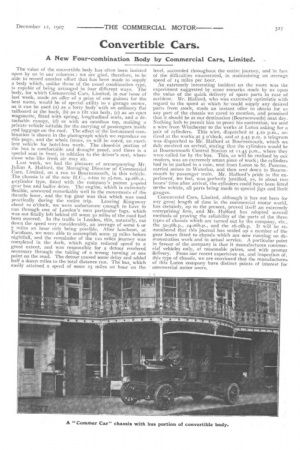Convertible Cars.
Page 3

If you've noticed an error in this article please click here to report it so we can fix it.
A New Four-combination Body by Commercial Cars, Limited.
The value of the convertible body has often been insisted upon by us in our columns:we are glad, therefore, to be able to record another effort that has been made to supply a body which, unlike those of the usual combination type, is capable of being arranged in four different ways. The body, for which Commercial Cars, Limited, in our issue of last week, made an offer of a prize of one guinea for the best name, would be of special utility to a garage owner, as it can be used (a) as a lorry body with an ordinary flat tailboard at the back, (b) as a tilt van body, (c) as an open wagonette, fitted with spring, longitudinal scats, and a detachable canopy, (d) or with an omnibus top, making a private vehicle suitable for the carrying of passengers inside and luggage on the roof. The effect of the last-named eombination is shown in the photograph which we reproduce on this page, and the whole forms, as will be noted, an excellent vehicle for hotel-bus work. The closed-in portion of the bus is comfortable and draught proof, and there is a special seat in front, in addition to the driver's seat, where those who like fresh air may sit.
Last week, we had the pleasure of accompanying Mr. Julian A. Halford, the Managing Director of Commercial Cars, Limited, on a run to Bournemouth, in this vehicle. The chassis is of the new H.C., 2-ton to 2:1-ton, 24-26h.p., 4-cylinder type, fitted with the company's patent 3-speed gear box and buffer drive. The engine, which is extremely flexible, answered remarkably well to the movements of the throttle lever, and the top gear was that which was used practically during the entire trip. Leaving Kingsway about TO o'clock, we were unfortunate enough to have to run through one of London's own particular fogs, which was not finally left behind till some 3o miles of the road had been covered. In the traffic in London, this, naturally, cut down the speed very considerably, an average of some 6 or 7 miles an hour only being possible. After luncheon, at Farnham, we were able to accomplish some 35 miles before nightfall, and the remainder of the Ito miles journey was completed in the dark, which again reduced speed to a great extent, and was responsible for a detour rendered necessary through the taking of a wrong turning at one point on the road. The detour caused some delay and added half a dozen miles to the total distance run. The bus, which easily attained a speed of some 23 miles an hour on the level, succeeded throughout the entire journey, and in face of the difficulties enumerated, in maintaining an average speed of 14 miles per hour.
An extremely interesting incident on the route was the experiment suggested by some remarks made by us upon the value of the quick delivery of spare parts in case of accident. Mr. Halford, who was extremely optimistic with regard to the speed at which he-could supply any desired parts from stock, made an instant offer to obtain for us any part of the chassis we cared to mention, and promised that it should be at our destination (Bournemouth) next day. Nothing loth to permit him to prove his contention, we sent a wire from Winchester to the works at Luton asking for a pair of Cylinders. This wire, dispatched at 4.10 p.m., arrived at the works at 5 o'clock, and at 5.45 p.m. a telegram was dispatched to Mr. Halford at Bournemouth, which we duly received on arrival, stating that the cylinders would be at Bournemouth Central Station at 11.45 p.m., where they were called for by the bus. This, as will be realised by our readers, was an extremely smart piece of work; the cylinders had to be packed in a case, sent from Luton to St. Pancras, carried across to Waterloo, and then sent down to Bourne. mouth by passenger train. Mr. Halford's pride in the experiment, we feel, was perfectly justified, as, in about two hours' time after arrival, the cylinders could have been fitted tor-the vehicle, all parts being made to special jigs and limit gauges.
Commercial Cars, Limited, although it has not been for any great length of time in the commercial motor world, has certainly, up to the present, proved itself an extremely enterprising firm, and Mr. Halford has adopted several methods of proving the reliability of the parts of the three types of chassis which are turned out by the company, viz., the 3o-36h.p., 24-26h.p., and the r6-i8h.p. It will be remembered that this journal has sealed up a number of the gear boxes fitted to chassis which are now running on demonstration work and in actual service. A particular point in favour of the company is that it manufactures commercial vehicles only, at reasonable prices, and with prompt delivery. From our recent experience on, and inspection of, this type of chassis, we are convinced that the manufactures of this Luton company have distinct points of interest for commercial motor users.




























